Ultrafast All-Optical Signal Modulation Induced by Optical Kerr Effect in a Tellurite Photonic Bandgap Fiber
Abstract
:1. Introduction
2. Fabrication and Properties of All-Solid Double-Clad Tellurite PBGF
3. Experiments and Results Discussion
4. Conclusions
Author Contributions
Funding
Acknowledgments
Conflicts of Interest
References
- Kerr, J. LIV. A new relation between electricity and light: Dielectrified media birefringent (second paper). Lond. Edinb Dublin Philos. Mag. J. Sci. 1875, 50, 446–458. [Google Scholar] [CrossRef]
- Maker, P.D.; Terhune, R.W.; Savage, C.M. Intensity-dependent changes in the refractive index of liquids. Phys. Rev. Lett. 1964, 12, 507. [Google Scholar] [CrossRef]
- Stolen, R.H.; Ashkin, A. Optical Kerr effect in glass waveguide. Appl. Phys. Lett. 1973, 22, 294–296. [Google Scholar] [CrossRef]
- Juvé, V.; Vaudel, G.; Ollmann, Z.; Hebling, J.; Temnov, V.; Gusev, V.; Pezeril, T. Ultrafast tunable modulation of light polarization at terahertz frequencies. Opt. Lett. 2018, 43, 5905–5908. [Google Scholar] [CrossRef] [PubMed]
- Subkhangulov, R.R.; Mikhaylovskiy, R.V.; Zvezdin, A.K.; Kruglyak, V.V.; Rasing, T.H.; Kimel, A.V. Terahertz modulation of the Faraday rotation by laser pulses via the optical Kerr effect. Nat. Photonics 2016, 10, 111–114. [Google Scholar] [CrossRef]
- Okamoto, K.; Marcatili, E.A.J. Chromatic dispersion characteristics of fibers with optical Kerr-effect nonlinearity. J. Lightware Technol. 1989, 7, 1988–1994. [Google Scholar] [CrossRef]
- Liu, L.; Tian, Q.J.; Liao, M.S.; Zhao, D.; Qin, G.S.; Ohishi, Y.; Qin, W.P. All-optical control of group velocity dispersion in tellurite photonic crystal fibers. Opt. Lett. 2012, 37, 5124–5126. [Google Scholar] [CrossRef]
- Mikhaylovskiy, R.V.; Subkhangulov, R.R.; Rasing, T.; Kimel, A.V. Colossal magneto-optical modulation at terahertz frequencies by counterpropagating femtosecond laser pulses in Tb3Ga5O12. Opt. Lett. 2016, 41, 5071–5073. [Google Scholar] [CrossRef]
- Agrawal, G.P. Nonlinear fiber optics. In Nonlinear Fiber Optics, 5th ed.; Elsevier: San Francisco, CA, USA, 2013; pp. 195–211. [Google Scholar]
- Domachuk, P.; Wolchover, N.A.; Cronin-Golomb, M.; Wang, A.; George, A.K.; Cordeiro, C.M.B.; Knight, J.C.; Omenetto, F.G. Over 4000 nm bandwidth of mid-IR supercontinuum generation in sub-centimeter segments of highly nonlinear tellurite PCFs. Opt. Express 2008, 16, 7161–7168. [Google Scholar] [CrossRef] [Green Version]
- Shen, S.X.; Jha, A.; Huang, L.; Joshi, P. 980-nm diode-pumped Tm3+/Yb3+-codoped tellurite fiber for S-band amplification. Opt. Lett. 2005, 30, 1437–1439. [Google Scholar] [CrossRef]
- Mori, A. Tellurite-based fibers and their applications to optical communication networks. J. Ceram. Soc. Jpn. 2008, 116, 1040–1051. [Google Scholar] [CrossRef] [Green Version]
- Kumar, V.V.R.K.; George, A.K.; Knight, J.C.; Russell, P.S. Tellurite photonic crystal fiber. Opt. Express 2003, 11, 2641–2645. [Google Scholar] [CrossRef] [PubMed]
- Gao, W.Q.; Cheng, T.L.; Deng, D.H.; Xue, X.J.; Suzuki, T.; Ohishi, Y. Third-harmonic generation with a more than 500 nm tunable spectral range in a step-index tellurite fiber. Laser Phys. Lett. 2014, 11, 095106. [Google Scholar] [CrossRef]
- Ohishi, Y.; Mori, A.; Yamada, M.; Ono, H.; Nishida, Y.; Oikawa, K. Gain characteristics of tellurite-based erbium-doped fiber amplifiers for 1.5-µm broadband amplification. Opt. Lett. 1998, 23, 274–276. [Google Scholar] [CrossRef]
- Wang, J.S.; Vogel, E.M.; Snitzer, E. Tellurite glass: A new candidate for fiber devices. Opt. Mater. 1994, 3, 187–203. [Google Scholar] [CrossRef]
- Schmidt, M.A.; Granzow, N.; Da, N.; Peng, M.; Wondraczek, L.; RussellP., S.T.J. All-solid bandgap guiding in tellurite-filled silica photonic crystal fibers. Opt. Lett. 2009, 34, 1946–1948. [Google Scholar] [CrossRef]
- Cheng, T.L.; Xue, X.J.; Gao, W.Q.; Suzuki, T.; Ohishi, Y. The Second-Order Raman Stokes Stronger Than the First-Order Raman Stokes Due to Inverse Raman Scattering in a Single Mode Tellurite Fiber. IEEE J. Quantum Electron. 2017, 53, 1–4. [Google Scholar] [CrossRef]
- Lin, A.; Zhang, A.; Bushong, E.J.; Toulouse, J. Solid-core tellurite glass fiber for infrared and nonlinear applications. Opt. Express 2009, 17, 16716–16721. [Google Scholar] [CrossRef]
- Luan, F.; George, A.K.; Hedley, T.D.; Pearce, G.J.; Bird, D.M.; Knight, J.C.; Russell, P.S.J. All-solid photonic bandgap fiber. Opt. Lett. 2004, 29, 2369–2371. [Google Scholar] [CrossRef]
- Bouwmans, G.; Bigot, L.; Quiquempois, Y.; Lopez, F.; Provino, L.; Douay, M. Fabrication and characterization of an all-solid 2D photonic bandgap fiber with a low-loss region (<20 dB/km) around 1550 nm. Opt. Express 2005, 13, 8452–8459. [Google Scholar] [CrossRef]
- Li, J.; Fan, P.C.; Sun, L.P.; Wu, C.; Guan, B.O. Few-period helically twisted all-solid photonic bandgap fibers. Opt. Lett. 2018, 43, 655–658. [Google Scholar] [CrossRef] [PubMed]
- Hu, X.W.; Shen, X.; Wu, J.J.; Peng, J.G.; Yang, L.Y.; Li, J.Y.; Li, H.Q.; Dai, N.L. All fiber M-Z interferometer for high temperature sensing based on a hetero-structured cladding solid-core photonic bandgap fiber. Opt. Express 2016, 24, 21693–21699. [Google Scholar] [CrossRef] [PubMed]
- Kong, F.T.; Gu, G.C.; Hawkins, T.W.; Jones, M.; Parsons, J.; Kalichevsky-Dong, M.T.; Palese, S.P.; Cheung, E.; Dong, L. Efficient 240 W single-mode 1018nm laser from an Ytterbium-doped 50/400 µm all-solid photonic bandgap fiber. Opt. Express 2018, 26, 3138–3144. [Google Scholar] [CrossRef] [PubMed]
- Li, G.R.; Zeisberger, M.; Schmidt, M.A. Guiding light in a water core all-solid cladding photonic band gap fiber—An innovative platform for fiber-based optofluidics. Opt. Express 2017, 25, 22467–22479. [Google Scholar] [CrossRef]
- Knight, J.C. Photonic crystal fibres. Nature 2003, 424, 847. [Google Scholar] [CrossRef]
- Cheng, T.L.; Sakai, Y.; Suzuki, T.; Ohishi, Y. Fabrication and characterization of an all-solid tellurite-phosphate photonic bandgap fiber. Opt. Lett. 2015, 40, 2088–2090. [Google Scholar] [CrossRef]
- Cheng, T.L.; Tanaka, S.; Tuan, T.H.; Suzuki, T.; Ohishi, Y. All-optical dynamic photonic bandgap control in an all-solid double-clad tellurite photonic bandgap fiber. Opt. Lett. 2017, 42, 2354–2357. [Google Scholar] [CrossRef]
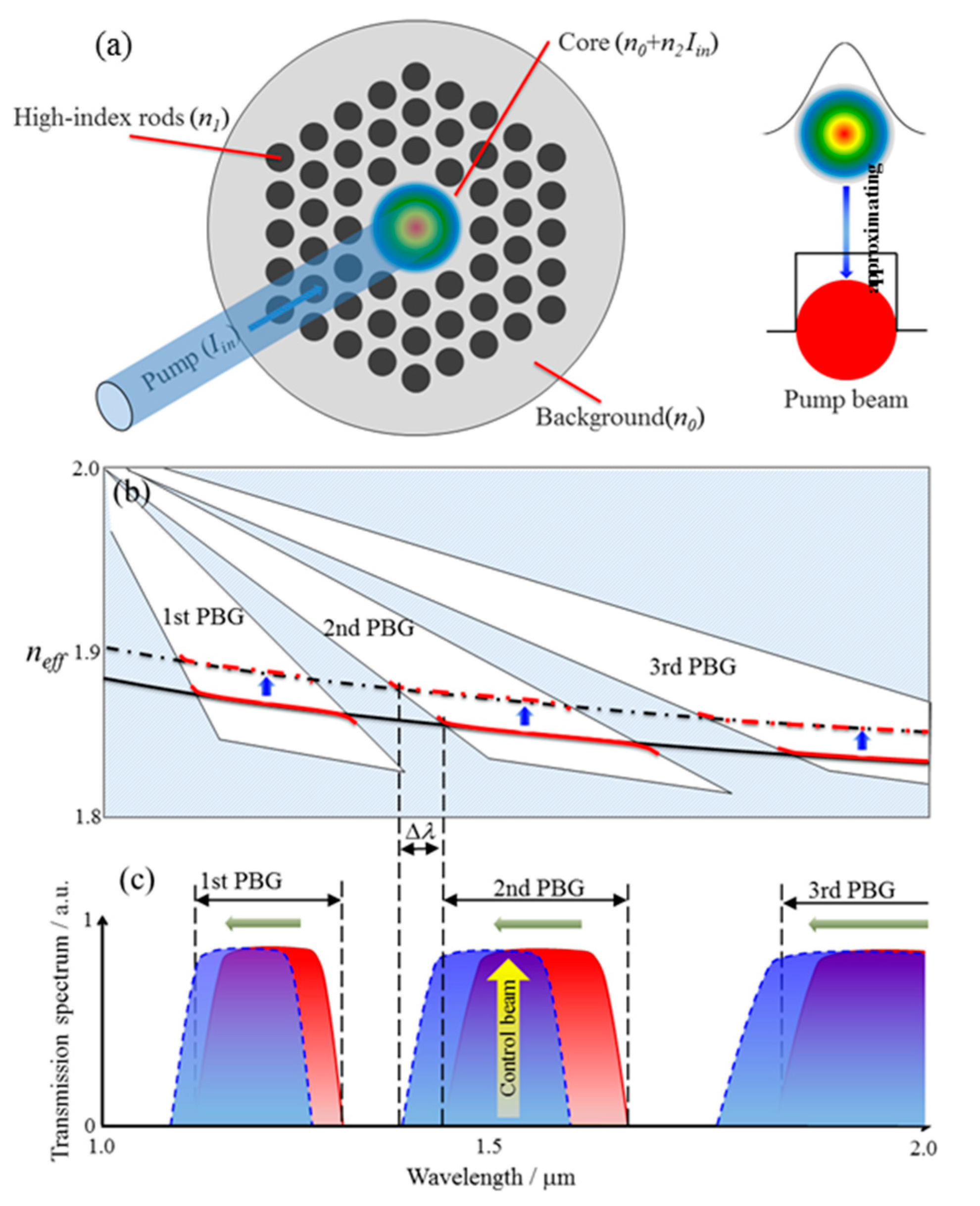
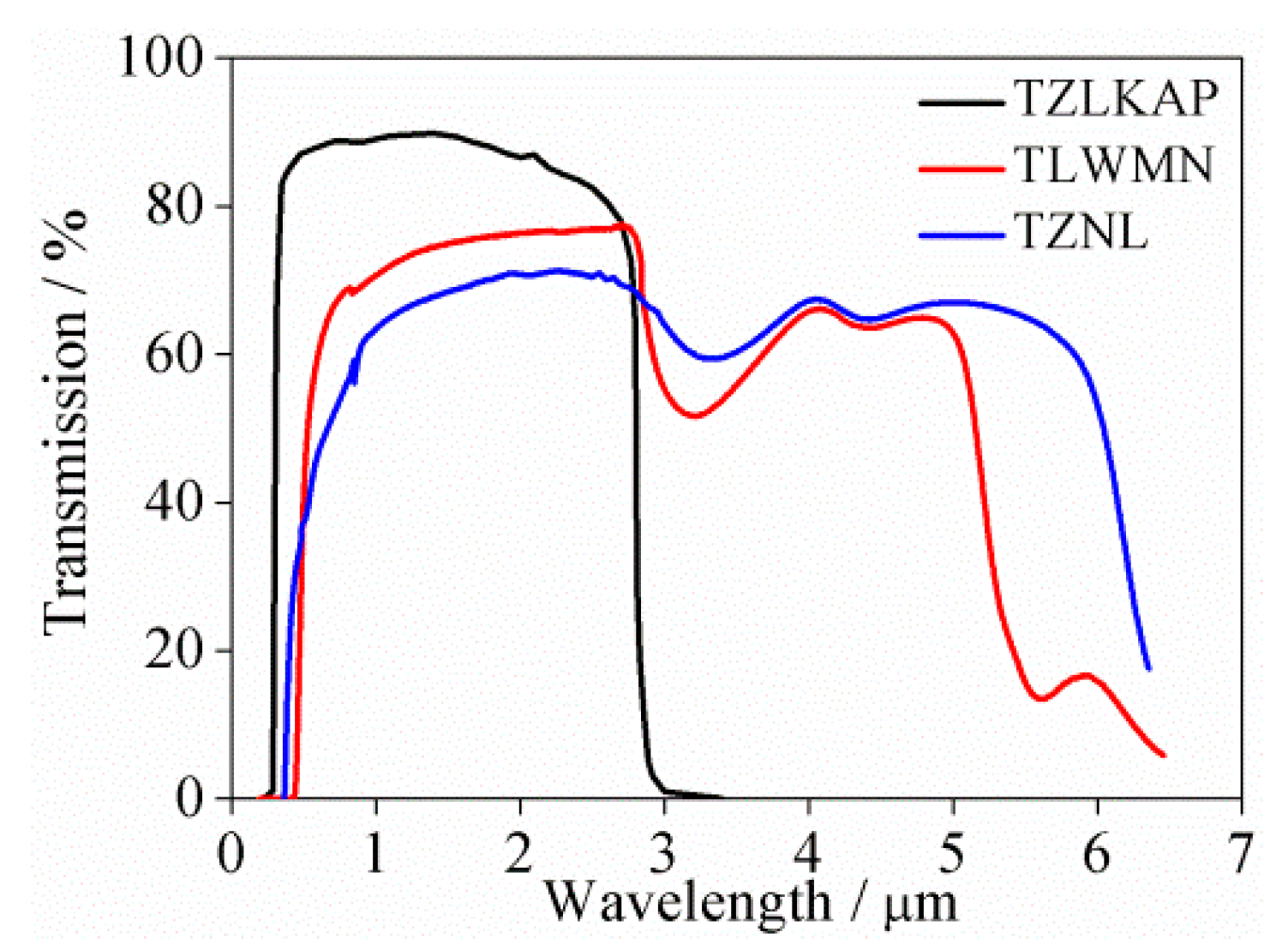
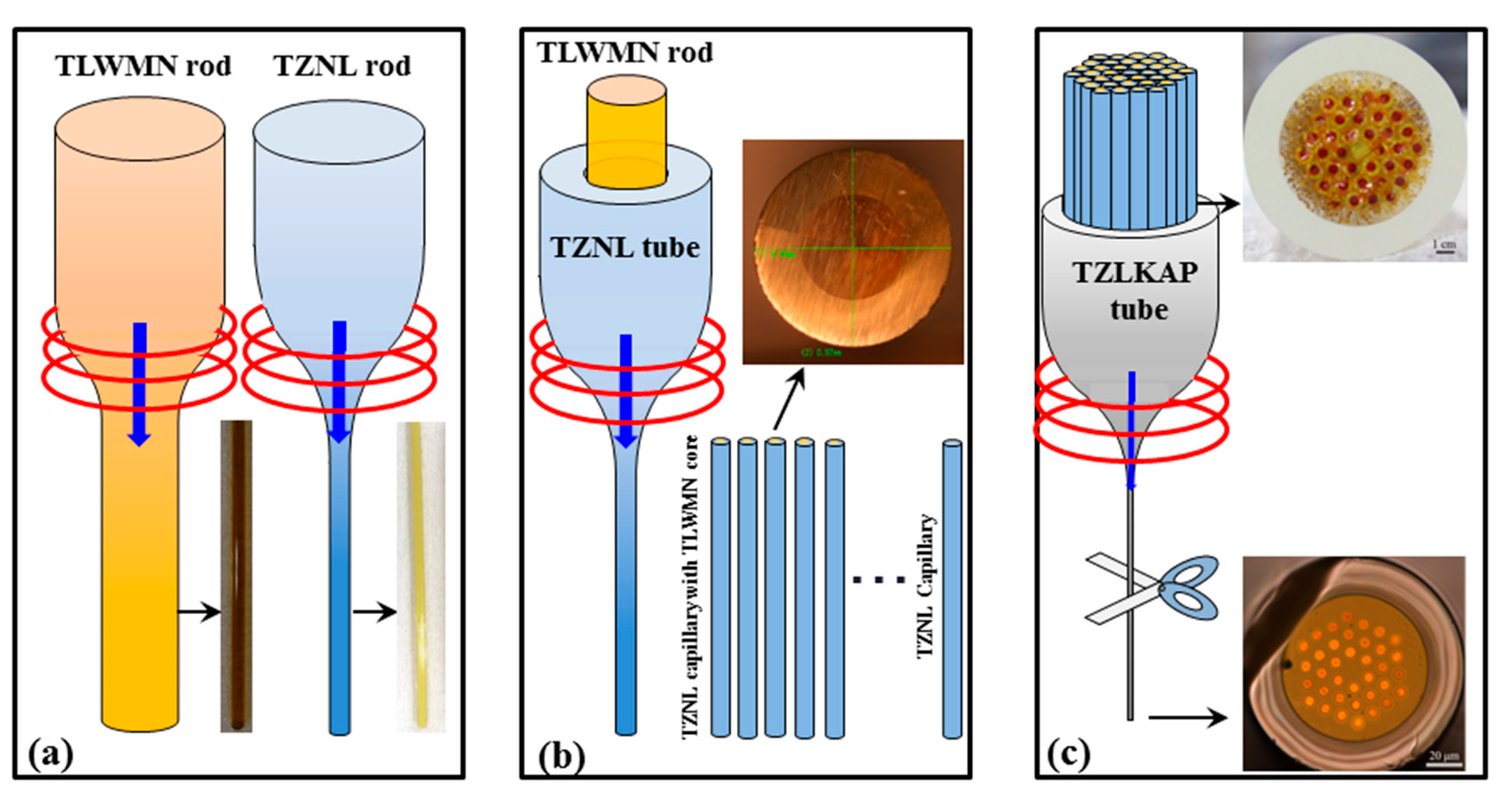
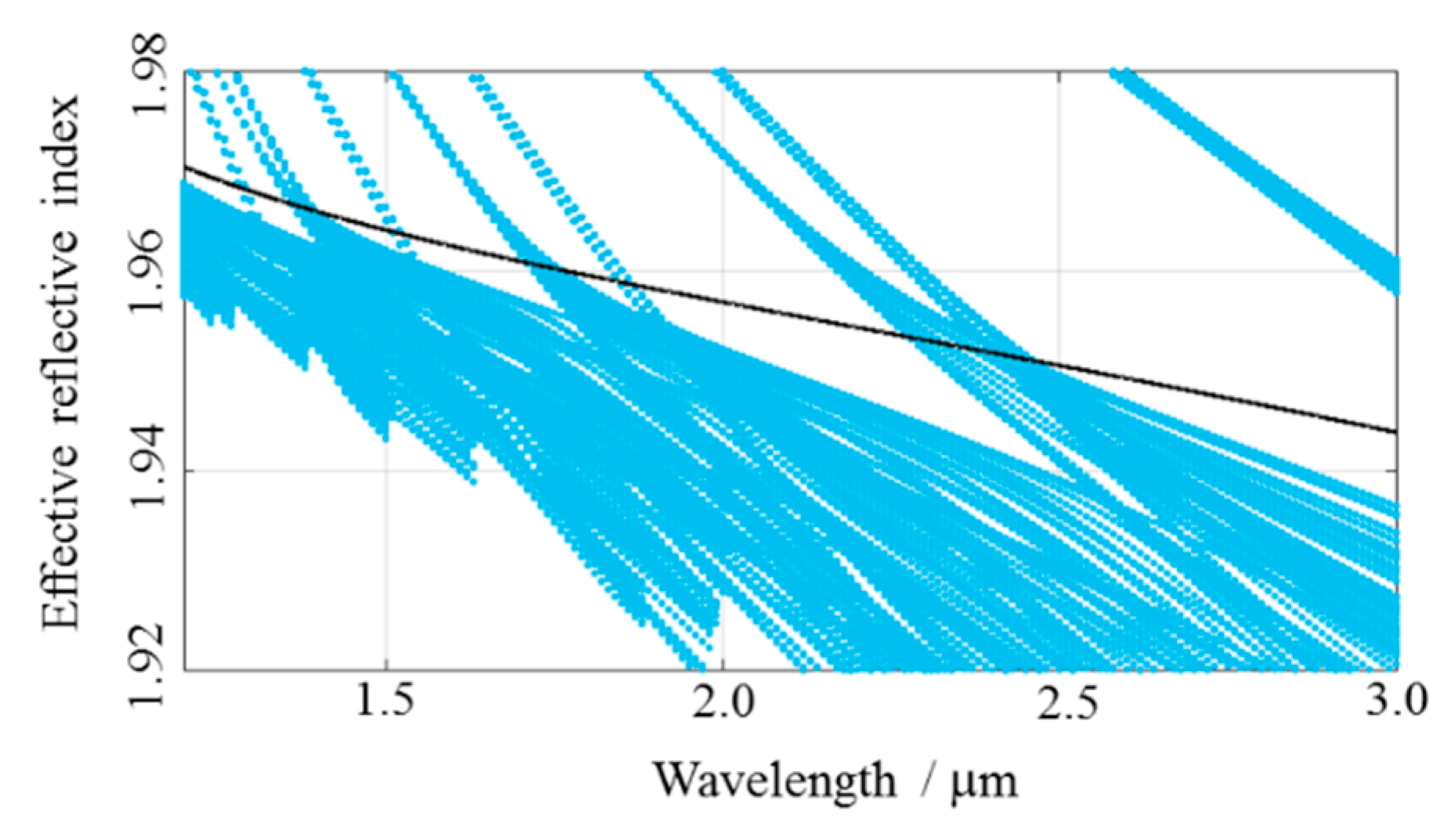
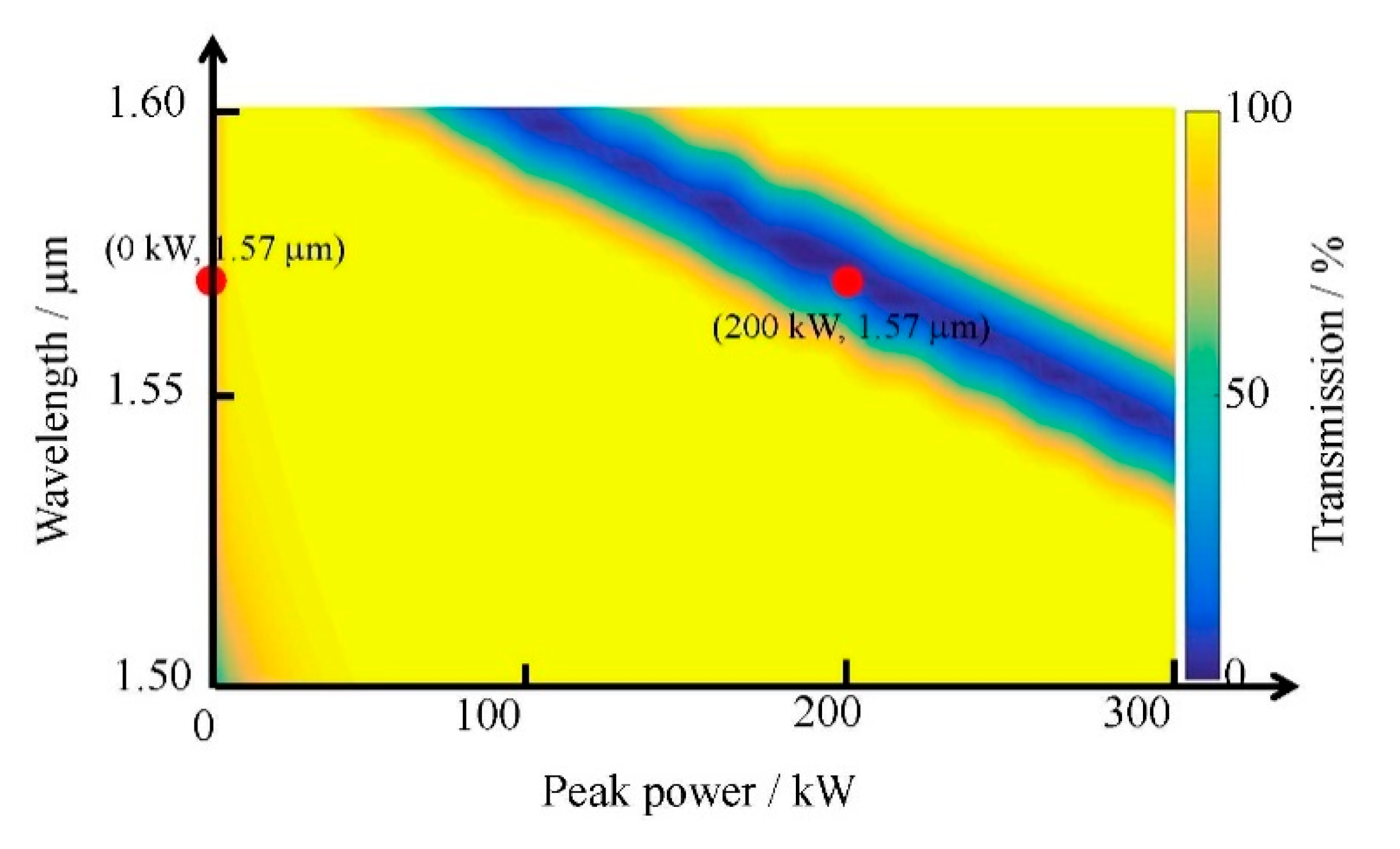
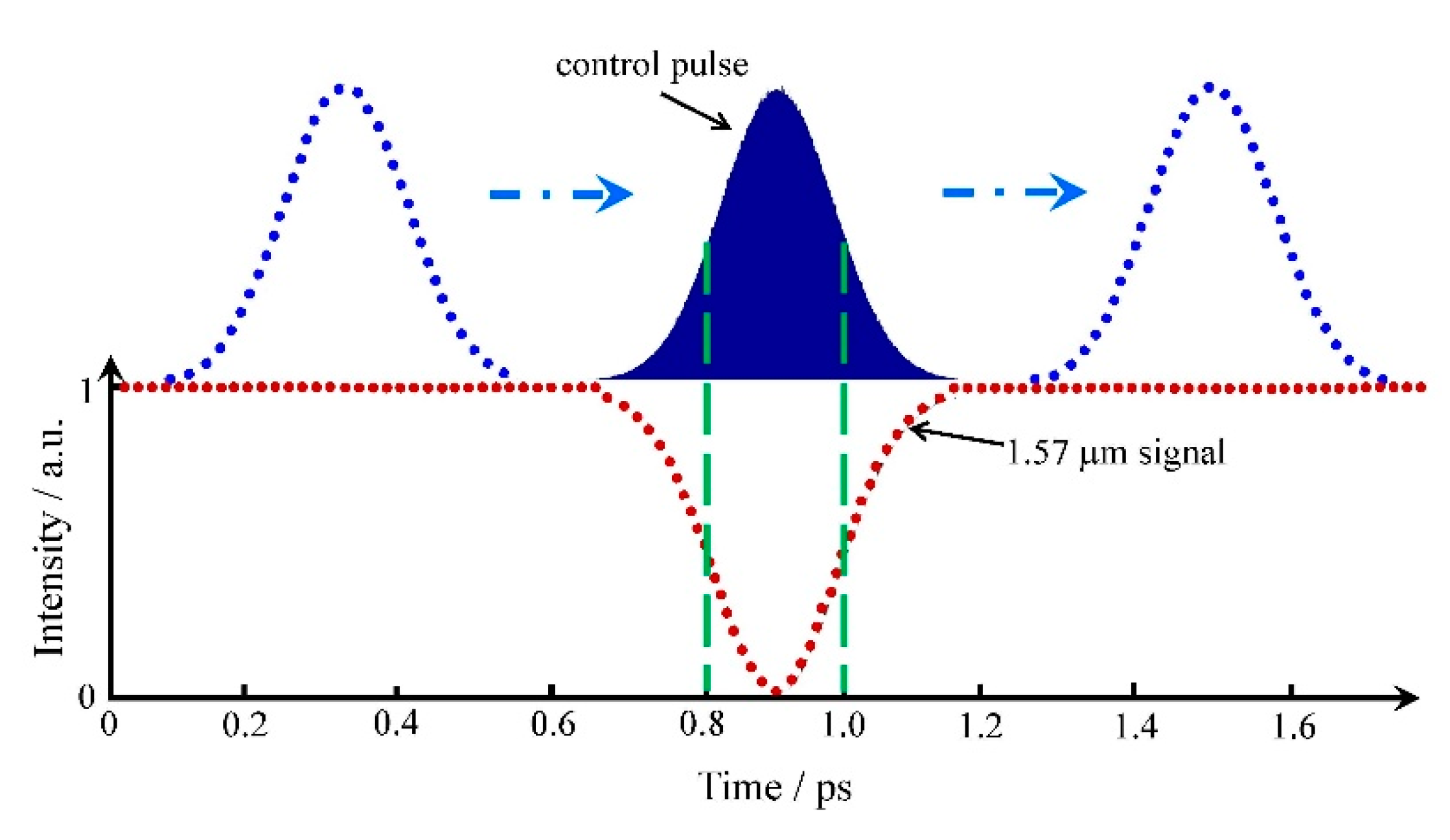
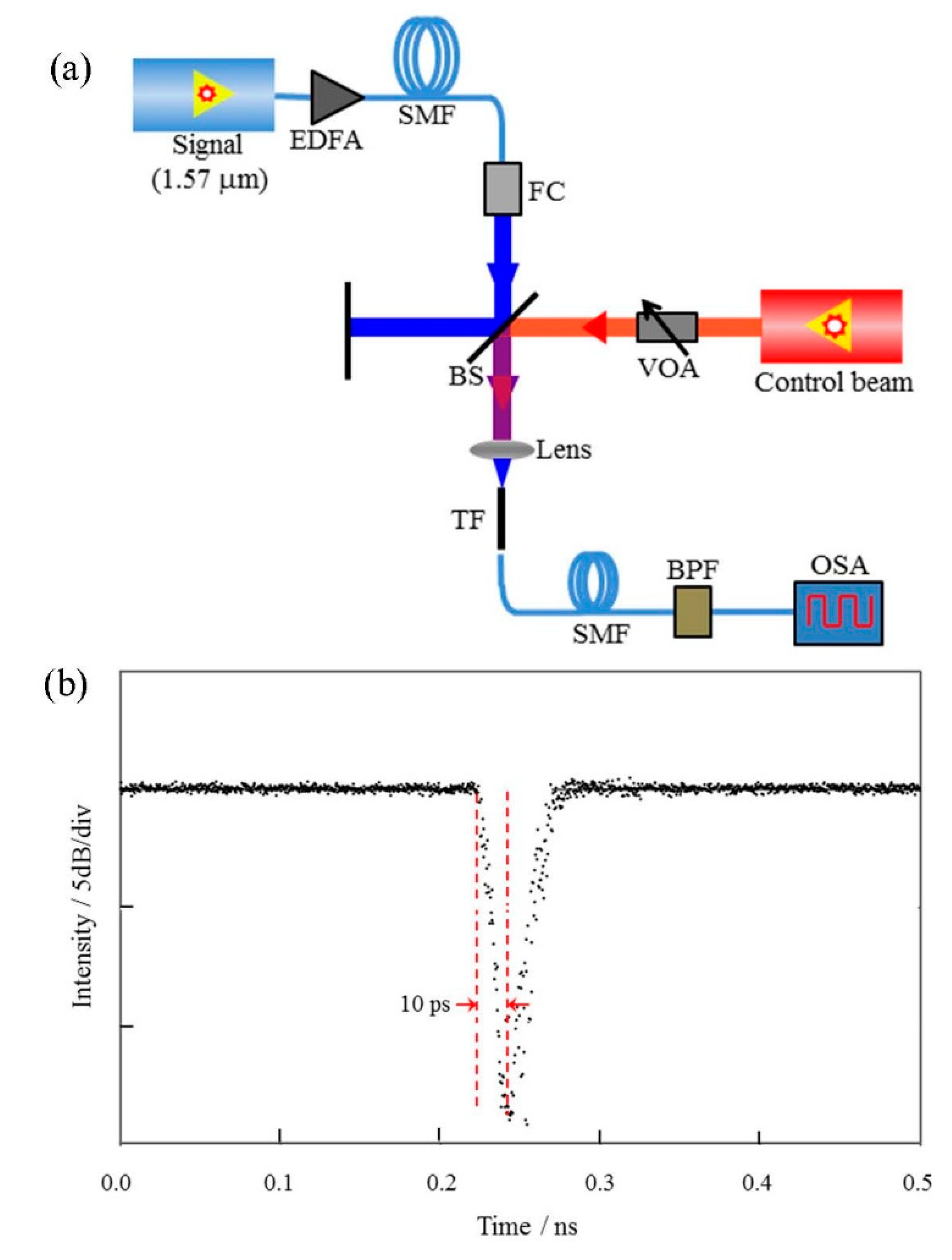
| Parameters | Materials | Reflective Index @ 1550 nm | Softening Temperatures/°C |
|---|---|---|---|
| High-index rod | TLWMN | 2.058 | 371 |
| Inner cladding | TZNL | 1.963 | 359 |
| Outer cladding | TZLKAP | 1.601 | 366 |
© 2019 by the authors. Licensee MDPI, Basel, Switzerland. This article is an open access article distributed under the terms and conditions of the Creative Commons Attribution (CC BY) license (http://creativecommons.org/licenses/by/4.0/).
Share and Cite
Cheng, T.; Zhang, F.; Tanaka, S.; Li, S.; Yan, X.; Zhang, X.; Suzuki, T.; Ohishi, Y. Ultrafast All-Optical Signal Modulation Induced by Optical Kerr Effect in a Tellurite Photonic Bandgap Fiber. Photonics 2019, 6, 113. https://doi.org/10.3390/photonics6040113
Cheng T, Zhang F, Tanaka S, Li S, Yan X, Zhang X, Suzuki T, Ohishi Y. Ultrafast All-Optical Signal Modulation Induced by Optical Kerr Effect in a Tellurite Photonic Bandgap Fiber. Photonics. 2019; 6(4):113. https://doi.org/10.3390/photonics6040113
Chicago/Turabian StyleCheng, Tonglei, Fan Zhang, Shunta Tanaka, Shuguang Li, Xin Yan, Xuenan Zhang, Takenobu Suzuki, and Yasutake Ohishi. 2019. "Ultrafast All-Optical Signal Modulation Induced by Optical Kerr Effect in a Tellurite Photonic Bandgap Fiber" Photonics 6, no. 4: 113. https://doi.org/10.3390/photonics6040113
APA StyleCheng, T., Zhang, F., Tanaka, S., Li, S., Yan, X., Zhang, X., Suzuki, T., & Ohishi, Y. (2019). Ultrafast All-Optical Signal Modulation Induced by Optical Kerr Effect in a Tellurite Photonic Bandgap Fiber. Photonics, 6(4), 113. https://doi.org/10.3390/photonics6040113





